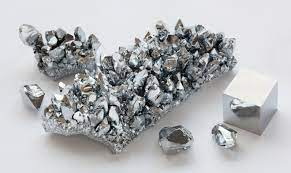Identity.
Chromium is a chemical element; it has symbol Cr and atomic number 24. It is the first element in group 6. It is a steely-grey, lustrous, hard, and brittle transition metal
Atomic Structure:
The nucleus consists of 24 protons (red) and 28 neutrons (orange). 24 electrons (white) successively occupy available electron shells (rings).
History.
Chromium's history is a fascinating blend of accidental discovery and purposeful innovation. Its journey began in 1797 when French chemist Louis Vauquelin was studying a vibrant red mineral called crocoite. He initially believed he had found a new form of lead, but further investigation revealed a unique element with compounds showcasing a remarkable range of colors. This characteristic earned it the name "chromium," derived from the Greek word for "color."
Throughout the 19th century, scientists delved deeper into chromium's properties and explored its potential uses. One key breakthrough came in the late 1800s with the development of stainless steel, an alloy incorporating chromium that offered superior resistance to rust and corrosion. This innovation revolutionized various industries, from food processing to architecture, and solidified chromium's place as a valuable industrial material.
Today, chromium continues to play a vital role in diverse applications. From strengthening steel in bridges and buildings to powering long-lasting batteries in electronics, its unique properties continue to benefit society in numerous ways.
Sources.
Chromium, a naturally occurring element, can be found in various places around the world, including:
- Chromium is present in numerous rock formations and minerals, like chromite, the primary source for industrial extraction.
- Trace amounts of chromium exist naturally in soil and water, absorbed by plants growing in these environments.
- Small quantities of chromium are present in various foods, such as meats, whole grains, fruits, and vegetables.
The specific sources and concentrations of chromium can vary depending on factors like geographic location, geological processes, and agricultural practices.

